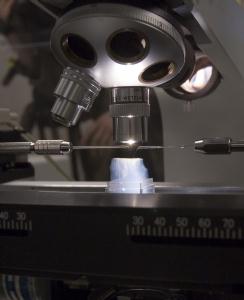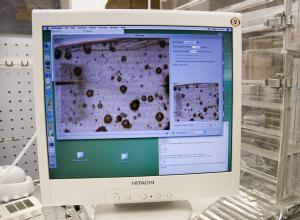NASA Study Finds New Kind of Organics in Stardust Mission

Special 'needles' mounted on
micro-manipulators controlled by computer to carefully and
precisely cut out sections of aerogel that contain cometary samples.
|
December 14, 2006
A team of scientists found a new class of organics in comet dust captured from comet Wild
2 in 2004 by NASA's Stardust spacecraft.
The discovery is described in a technical paper, "Organics Captured from Comet Wild 2 by
the Stardust Spacecraft," in the Dec. 15 issue of Science Express, the online edition of the
journal Science.
In January 2004, the Stardust spacecraft flew through comet dust and captured specks of it
in a very light, low-density substance called aerogel. Stardust's return capsule parachuted to
the Utah Test and Training Range on Jan. 15, 2006, after a seven-year mission. The
science canister containing the comet particles and interstellar dust particles arrived at
Johnson Space Center on Jan. 17. From there, the cometary samples have been processed
and distributed to about 150 scientists worldwide who are using a variety of techniques to
determine the properties of the cometary grains.
"A portion of the organic material in the samples is unlike anything seen before in
extraterrestrial materials," said Scott Sandford, the study's lead author and a scientist from
NASA's Ames Research Center in California's Silicon Valley. "Capturing the particles in
aerogel was a little bit like collecting BBs by shooting them into Styrofoam."
The comet organics collected by the Stardust spacecraft are more "primitive" than those
seen in meteorites and may have formed by processes in nebulae, either in space clouds
between the stars, or in the disk-shaped cloud of gas and dust from which our solar system
formed, the study's authors found.
"Comets are a major source of the water and carbon on the moon," said S. Pete Worden,
NASA Ames director. "Therefore, understanding comets will help scientists learn what
natural resources to search for on our nearest neighbor in space -- resources that will aid
astronauts in exploration beyond Earth," Worden explained.

Image of the glass needle performing the
first series of cuts. Researchers can monitor the progress of the
keystone operation from the computer monitor or from outside the
cleanroom.
|
The study's scientists used many highly sophisticated, state-of-the-art techniques to analyze
the Stardust samples.
Several of the analyses indicated that the samples contain polycyclic aromatic hydrocarbons
(PAHs), scientists said. PAHs are molecules made of carbon and hydrogen that are
common in interstellar space - and in barbeque grill soot.
Certain PAHs chemical varieties also contain oxygen and nitrogen. Some scientists believe
that these PAHs variants exist in interstellar space as well. They are of interest to
astrobiologists because these kinds of compounds play important roles in terrestrial
biochemistry, according to Sandford.
"Our studies of the comet dust show that the organics are very rich in oxygen and nitrogen,"
Sandford said. "The data are not incompatible with some of it being in the PAHs, but we still
have a lot to learn in this area."
Although some of the other organics captured by the Stardust spacecraft look somewhat
similar to the fairly stable organics found in meteorites, Sandford noted that many of the
organic compounds appear to be very volatile. One sample even showed an abundance of
material containing alcohols.
Many scientists believe that comets are largely made of the original material from which our
solar system formed and could contain pre-solar system, interstellar grains. According to
scientists, continued analysis of these celestial specks may well yield important insights into
the evolution of the sun, its planets and possibly, even the origin of life.
"I anticipate that people will be asking for and working on these samples for decades to
come," said Sandford. "What we report in the papers that appear this week is just the
beginning of what we will learn from these samples. One of the advantages of returned
samples is that they are available for study into the future, a gift that keeps on giving."
The organics paper is one of seven in the journal Science reporting the findings of the
preliminary examination team that made the initial study of the cometary samples.
The Jet Propulsion Laboratory, Pasadena, Calif., manages the Stardust mission for NASA's
Science Mission Directorate, Washington. Dr. Peter Tsou of JPL is deputy principal
investigator and is a co-author of the paper.
For more information about Stardust studies and other mission information, visit:
http://stardust.jpl.nasa.gov/ .
JPL Media Contact for Stardust:
DC Agle
Phone: 818-393-9011
agle@jpl.nasa.gov
|
